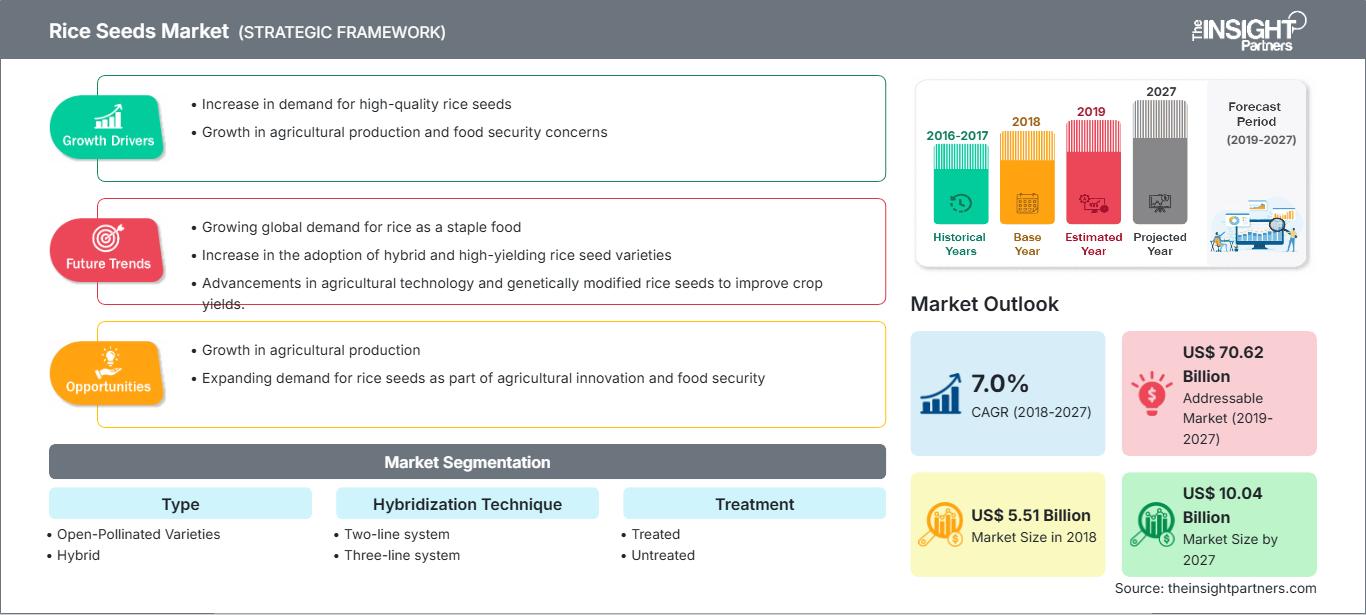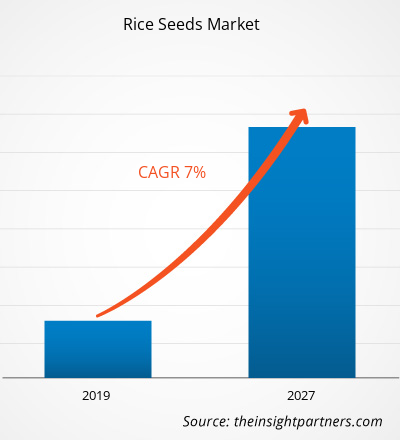イネ種子市場は2018年に55億680万米ドルと評価され、2027年までに100億3600万米ドルに達すると予測されています。また、2019年から2027年にかけて7.0%のCAGRで成長すると見込まれています。
米は多くの主要国、特にアジア太平洋地域で主食となっています。パディとしても知られるイネ種子は、丸ごとのイネの種子であり、パディ1粒には1つの米粒が含まれています。これは、Oryza glaberrimaまたはL. Oryza sativaの種子です。さらに、イネ種子は、ペプチドや治療用タンパク質などのヒト用医薬品を製造するためのバイオリアクターとして使用されます。アジア太平洋地域のイネ種子市場は、予測期間中に最も高いCAGRで成長すると予想されています。この地域の市場成長は、特にインドや中国などの国で継続的に増加している高い人口密度に主に起因しています。さらに、アジア諸国では人口の約4分の1が貧困層に属しています。これらの国々は、アジア太平洋諸国における米消費を牽引すると期待されています。しかしながら、日本や韓国など所得水準の高い国では、一人当たりの米消費量は減少に転じています。人口増加と耕作地不足は、世界の米種子市場において解決すべき2つの大きな課題です。アジア太平洋地域全体で高まる需要に応えるためには、稲作の生産性向上が不可欠です。
要件に合わせてレポートをカスタマイズ
レポートの一部、国レベルの分析、Excelデータパックなどを含め、スタートアップ&大学向けに特別オファーや割引もご利用いただけます(無償)
米種子市場: 戦略的洞察

-
このレポートの主要な市場動向を入手してください。この無料サンプルには、市場動向から見積もりや予測に至るまでのデータ分析が含まれます。
世界人口の増加に伴い、今後数年間で増加する食糧消費を満たすための米の需要が高まると予想されています。しかし、水と土地資源が限られているため、米の増産は農家にとって課題となっています。この問題を解決する唯一の解決策は、イネ種子の生産性を高めることです。過去数年間、世界の一部の地域では、主に米の収量の潜在的向上がわずかにしか見られなかったため、イネの生産性は停滞または低下しています。ハイブリッド種子の開発は、各国がイネの生産性を高め、イネ生産の自給自足を達成するための解決策を提供します。分子生物学、バイオテクノロジー、ゲノミクスの分野における技術の進歩により、ハイブリッド米の育種は大幅に改善されました。これに加えて、ハイブリッド米種子生産分野における継続的な研究開発投資と官民連携(PPP)の高まりが、特に商業農家におけるハイブリッド種子の採用をさらに増加させています。これらすべての要因が、予測期間中にハイブリッド種子の需要を押し上げると予想されます。
タイプ別インサイト
タイプに基づいて、米種子市場は開放受粉品種とハイブリッドに分かれています。開放受粉品種(OPV)の米種子は、親植物の自然受粉によって生産されます。このカテゴリーの受粉方法には、自家受粉、昆虫、鳥、その他の自然受粉が含まれます。ハイブリッド種子とは異なり、これらの種子は親植物と同一の植物を生産し、場合によっては標準品種として知られています。OPVの選択は、生産者の要件によって異なります。OPVは、効率的に維持・生産されれば、増殖しても同じ特性を維持します。OPV米種子は、生育条件や地域の気候に応じてゆっくりと適応するため、遺伝的に多様な特性を示します。商業栽培者は、高収量と特定の望ましい特性を求めて、OPVよりもハイブリッド種子を好みます。ハイブリッド種子にはOPVを超える利点がいくつかありますが、OPVは植物の遺伝的多様性の保全に役立ちます。自然栽培の米やその他の食品の世界的な需要の増加は、今後数年間でOPV市場を牽引すると予想されています。
ハイブリダイゼーション技術の洞察
ハイブリダイゼーション技術に基づいて、イネ種子市場は2系統システムと3系統システムに分割されます。2018年には、2系統システムセグメントが最大の市場シェアを占めました。2系統ハイブリッドの利点には、維持系統が不要であること、雑種交配種を開発するための親の選択肢が広いこと、不妊細胞質による悪影響がないことが挙げられます。全体的な2系統種子の生産は、3系統ハイブリッドとそれほど変わりません。2系統ハイブリッド種子の生産における重要な考慮事項の1つは、適切な場所または季節の決定です。 2 系統システムの利点により、予測期間中に 2 系統ハイブリッドの需要が促進されると予想されます。
イネ種子市場で事業を展開している企業としては、BASF SE、Bayer AG、DuPont de Nemours、Inc.、Guard Rice Mills、Kaveri Seeds、Mahyco、Nuziveedu Seeds Limited、Rallis India Limited、Rasi Seeds (P) Ltd.、SL-Agritech などが挙げられます。主要企業は、合併や買収、研究開発戦略を実施して顧客基盤を拡大し、世界市場で大きなシェアを獲得し、ブランド名を世界的に維持することにも成功しています。
レポートの注目点
- 米種子市場における進歩的な業界動向。プレーヤーが効果的な長期戦略を策定するのに役立ちます
- 先進国と発展途上国が採用しているビジネス成長戦略
- 2019年から2027年までの米種子市場の定量分析
- 米種子の世界需要の推定
- 業界で事業を展開しているバイヤーとサプライヤーの有効性を示すPEST分析
- 競争の激しい市場シナリオを理解するための最近の動向
- 米種子市場の成長を促進および抑制する要因、市場動向と展望
- 商業的関心を支え、市場の成長につながる市場戦略を強調することで、意思決定プロセスを支援
- さまざまなノード
- 市場の詳細な概要とセグメンテーション、および米種子業界の動向
- 有望な成長機会のあるさまざまな地域の米種子市場の規模
米種子市場の地域別分析
予測期間を通じて米種子市場に影響を与える地域的な傾向と要因は、The Insight Partnersのアナリストによって徹底的に説明されています。このセクションでは、北米、ヨーロッパ、アジア太平洋、中東・アフリカ、中南米における米種子市場のセグメントと地域についても説明します。
米種子市場レポートの範囲
| レポート属性 | 詳細 |
|---|---|
| の市場規模 2018 | US$ 5.51 Billion |
| 市場規模別 2027 | US$ 10.04 Billion |
| 世界的なCAGR (2018 - 2027) | 7.0% |
| 過去データ | 2016-2017 |
| 予測期間 | 2019-2027 |
| 対象セグメント |
By タイプ
|
| 対象地域と国 |
北米
|
| 市場リーダーと主要企業の概要 |
|
米種子市場のプレーヤー密度:ビジネスダイナミクスへの影響を理解する
米種子市場は、消費者の嗜好の変化、技術の進歩、製品の利点に対する認知度の高まりといった要因によるエンドユーザーの需要増加に牽引され、急速に成長しています。需要の増加に伴い、企業は製品ラインナップの拡充、消費者ニーズへの対応のための革新、そして新たなトレンドの活用を進めており、これが市場の成長をさらに加速させています。

- 入手 米種子市場 主要プレーヤーの概要
- 開放受粉品種 (OPV)
- ハイブリッド
米種子市場 - 交配技術別
- 2 系統システム
- 3 系統システム
米種子市場 - 処理方法別
- 処理済み
- 未処理
米種子市場 -粒度別
- 長粒種
- 中粒種
- 短粒種
企業プロフィール
- BASF SE
- Bayer AG
- EI du Pont de Nemours and Company
- Guard Rice Mills
- Kaveri Seed Company Ltd
- Maharastra Hybrid Seeds Company Private Limited (Mahyco)
- Nuziveedu Seeds Ltd. (NSL)
- Rallis India Limited
- Rasi Seeds (P) Ltd.
- SL Agritech Corporation
- 過去2年間の分析、基準年、CAGRによる予測(7年間)
- PEST分析とSWOT分析
- 市場規模価値/数量 - 世界、地域、国
- 業界と競争環境
- Excel データセット
最新レポート
関連レポート
お客様の声
購入理由
- 情報に基づいた意思決定
- 市場動向の理解
- 競合分析
- 顧客インサイト
- 市場予測
- リスク軽減
- 戦略計画
- 投資の正当性
- 新興市場の特定
- マーケティング戦略の強化
- 業務効率の向上
- 規制動向への対応






















 無料サンプルを入手 - 米種子市場
無料サンプルを入手 - 米種子市場